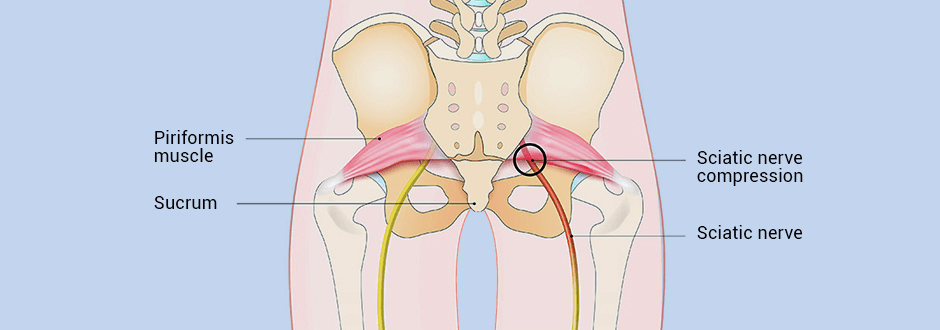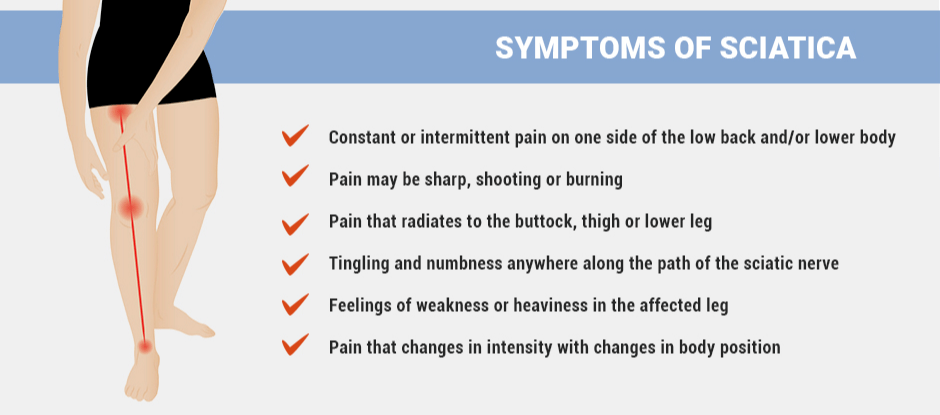Sciatic nerve pain is one of the most common and most misunderstood medical complaints of adult patients. It is estimated that upwards of 40 percent of people will experience sciatica at some point during their lifetime, and the incidence increases with age. As many as 15 percent of sciatica sufferers opt for surgery, despite the fact that long-term surgical outcomes are similar to those of conservative care offered by a chiropractor or sciatica specialist.
The term sciatica refers to non-specific low back pain associated with irritation of the sciatic nerve. It often occurs independently, but may also arise in conjunction with other conditions such as a herniated disc, degenerative disc disease, spinal stenosis, tumors or trauma. The sciatic nerves are the largest and longest in the human body. They are about the diameter of your pinky finger, and originate at the spinal roots of lumbar vertebrae L4-L5, and sacral vertebrae S1, S2, and S3. From there, they exit the pelvis and travel to the piriformis muscle before descending down your leg, all the way to your feet. The sciatic nerves are the primary messengers of neural impulses and information between the lower body and the central nervous system.
Common causes of sciatica include:
- A herniated lumbar disc that puts pressure on a nerve root
- Inflammation of nearby tissues that compress the nerve root
- Entrapment of the nerve root by the piriformis muscle
- Poor spinal alignment from sitting
- Poor lifting technique, or lifting too-heavy objects
- Obesity that overloads the spine
- Poor gait mechanics that puts stress on the low back
- Age-related conditions such as stenosis, osteoarthritis or degenerative disc disease
Because of their location in the lumbopelvic region where load transfer occurs between the upper and lower body, the sciatic nerves are vulnerable to trauma from sports. However, most sciatic nerve pain occurs in sedentary populations. In most cases, there is no specific structural damage to the sciatic nerves or surrounding tissues, making the pain “non-specific” in nature.
Most sciatica sufferers are not athletic. They tend to be sedentary, and sit for long hours on end. Many are overweight, with weak muscles and poor posture. Physical inactivity is one of the primary risk factors for sciatic nerve pain. Age-related spinal changes can also increase your risk, along with diabetes, which increases your risk of nerve damage.
Symptoms of sciatica include:
- Constant or intermittent pain on one side of the low back and/or lower body
- Pain may be sharp, shooting or burning
- Pain that radiates to the buttock, thigh or lower leg
- Tingling and numbness anywhere along the path of the sciatic nerve
- Feelings of weakness or heaviness in the affected leg
- Pain that changes in intensity with changes in body position
Chronic lower back pain should not be ignored. Sciatica symptoms may be similar or identical to those of other spinal conditions. If you suspect you have sciatica, you should see a chiropractor or other sciatica specialist.
Because sciatica is often extremely painful, many patients are dismayed when they are not referred for MRI imaging. However, if the clinical exam reveals no suspicion of structural damage, an MRI can be a waste of time and money, and waiting for results can exacerbate pain and prolong treatment.
At NYDNRehab, we confirm our diagnosis with high-resolution diagnostic ultrasonography, which lets us view the entire length of the sciatic nerve in real time. Ultrasonography is fast, simple and pain-free. Because the patient is able to move during imaging, we are able to view the nerves from different angles and body positions while the patient provides feedback.
Sciatica usually resolves itself within 4 to 6 weeks of non-surgical care.
Conservative sciatica treatment may include:
Seeking proactive treatment for sciatic nerve pain can speed recovery and prevent future relapses.
If you are suffering from chronic low back pain and think you need a sciatica doctor, contact the back pain specialists at NYDNRehab in Manhattan. Our state-of-the-art clinic uses the most advanced technologies and innovative methods to diagnose and treat your low back pain.
At NYDNR, we don’t just address your pain. We get to the source and correct it, so you can enjoy a better, pain-free quality of life.
Resources:
Jensen, Rikke K., et al. “Diagnosis and treatment of sciatica.” bmj 367 (2019).
Lewis, Ruth, et al. “The clinical effectiveness and cost effectiveness of management strategies for sciatica: systematic review and economic model.” Health Technology Assessment 15.39 (2011): 1-434.




























































